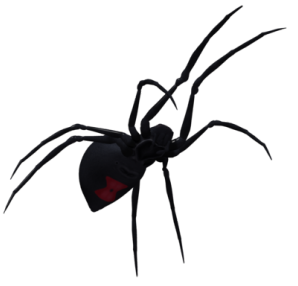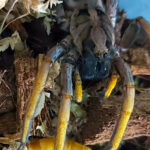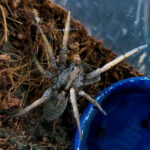Hogna schmitzi (Madeira's Wolf Spider)
Country of Origin: Madeira Island, Portugal
The Name:
The genus name “Hogna” is derived from Greek mythology, where Hogna was a giant, reflecting the spider’s size and imposing presence. The species name “schmitzi” honors the German entomologist Karl Schmitz, who contributed significantly to the study of arachnids in the Madeira region.
Natural Environment and Behavior:
This species thrives in rocky and semi-arid environments typically found on the island. Their natural habitat includes cliffs and dry, rocky terrain where they can easily find crevices and small caves to use as shelters.
Hogna schmitzi exhibits both terrestrial and burrowing behaviors. They are known for their agility and active hunting style, rather than relying on webs to catch prey. This species is known to create burrows or use natural shelters as retreats, which they line with silk for added stability and comfort. In captivity, providing a substrate mix of clay, fine sand, and soil is recommended to mimic their natural environment and support their burrowing habits.
These spiders can display defensive behaviors when threatened, including raising their front legs and displaying their fangs. It is essential to approach them with caution to avoid causing stress or provoking a defensive response.
Diet:
In the wild, Hogna schmitzi preys on various small invertebrates. They are opportunistic hunters, relying on their speed and stealth to capture prey. In captivity, they should be fed live insects such as crickets, roaches, and mealworms. The frequency and size of feedings should be adjusted according to the spider’s age and size.
Husbandry:
To ensure the well-being of Hogna schmitzi in captivity, it is crucial to maintain a semi-arid environment that replicates their natural habitat. This includes maintaining moderate humidity levels and providing ample ventilation to prevent excessive moisture. The temperature should be kept within a range of 24-29°C during the day, with a slight drop at night.
Substrate should be kept slightly damp but not wet, using a mix that supports burrowing. Providing hiding spots such as cork bark or rocks is essential for the spider to feel secure. Regular monitoring of the enclosure’s conditions will help ensure the spider’s health and comfort.
Longevity:
Females can live up to 5 years, while males typically live around 2 to 3 years.
Size:
They range from 2.5 to 3 cm in body length, with a leg span of up to 7 cm.
Husbandry:
Maintain humidity between 50-60% and temperature between 22-26°C. Use a mixture of sandy soil and rocks to replicate the natural substrate.
Enclosure Size:
Slings: An enclosure approximately 5-10 cm in length and width is suitable.
Juveniles: Should transition to an enclosure with dimensions of approximately 15-20 cm.
Adults: Require dimensions of at least 30x30x30 cm to provide enough space for their active hunting behavior.


